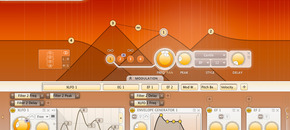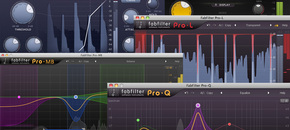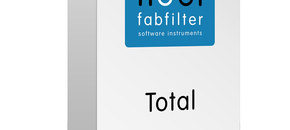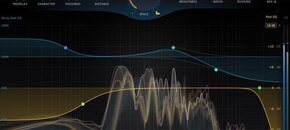Fabfilter - Saturn
Fans of distortion are really getting spoiled these days aren't they? It seems like it was just yesterday that we took a close look at Audio Damage's newest offering, and now another major plugin maker is getting into the game. We're referring to FabFilter, the Dutch crew that has made a name for themselves by releasing great sounding plugins with a concentration on user interfaces that are both intuitive and sophisticated.
Their newest release is a multiband distortion plugin called Saturn, which promises to "take your music to the outer limits." In addition to that celestial claim, the FabFilter press materials list an impressive number of features that have been built into Saturn. Included are 16 different distortion flavors, dynamic multiband processing, mid/side processing and the same vaunted modulation engine found in their other creative plugins (Volcano, Timeless and Twin).
When you open an instance of Saturn and begin to run audio through it, you're immediately greeted by one of the major selling points of the FabFilter products—a useful real-time audio display. In this case, since Saturn allows you to process separate parts of the audio signal independently, the audio display shows the volume levels spread across the frequency spectrum. This allows you to accurately determine where to place the multiband separators by watching this display react to your music over time. Additionally, unlike most multiband distortions, which usually have a fixed number of frequency bands, Saturn starts with just one band covering the full spectrum by default. You can then easily and dynamically create new bands by placing dividers on top of the display of the incoming audio.
Each active band within Saturn has its own set of controls to affect its section of the audio signal. The most fundamental of these controls is a dropdown that allows you to pick one of the distortion engines. These engines can be generally categorized into five different types—tube, tape, amp, saturation and experimental. Even with 16 different options, in many cases it feels like the engines within each category are a little too closely related—as if they are the using the same algorithm with a varied amount of one or two parameters.
Once you've chosen the distortion engine for a band, you essentially get one knob labeled DRIVE to control the character and amount of the distortion applied to your signal. Technically speaking, it determines how much of the clipping stage is driven with the input signal—and for Smudge (one of the experimental engines) it also serves double duty by controlling the amount of audio signal being repeated. It would be nice to have at least one more knob to control engine-specific parameters here. This is the case especially for Smudge, which feeds back grains of audio into the signal. Without being able to modify the grain size, this engine can start to sound like a one-trick-pony.
As it turns out though, distortion is just one part of the audio processing path within Saturn. Every band also includes four EQ sliders that allow you to fine tune the bass, middle, treble and presence of the audio after it has been run through the distortion engine. Even more sonic mayhem can be introduced by using the two feedback knobs, which control the amount and frequency of feedback for each band. This can easily send things out of control, but thankfully FabFilter provides a global Auto Mute switch that can save your monitors (and ears) from the pain that feedback can inflict.
Perhaps the most useful of the band controls is the Dynamics knob. This deceivingly simple knob can be used to either compress or expand the dynamics of audio within a band. Despite its simplicity, we found it to be unexpectedly effective. Combined with the dynamic band processing, this essentially turns Saturn into a very useful multiband compressor / expander—a pleasant surprise. Saturn can also be switched into mid/side mode, which takes things even further into the realm of advanced mixing tools.
So far so good, but it takes more than multiband processing and distortion to take music "to the outer limits." To get there you need to dig into the sophisticated modulation system that the FabFilter team has refined over the past few years. Saturn supports six different types of modulation sources. These include XLFO, XY controller, envelope generator, envelope follower and incoming MIDI. Each of the sources has its own tricks and nuances. For example, by default the XLFO acts like a standard LFO that you would find on countless other plugins, but it can also be expanded to allow for custom user-designed waveforms. The envelope follower and generator sources are very useful for modulation based on the volume of the incoming signal, and they can also be configured to listen to a sidechain signal via an additional input that Saturn provides.
Connecting modulation sources to parameters on the plugin is as simple as it gets: click and drag from the source to any parameter on any band. We did notice one issue with this system though: adding additional bands to a patch with existing modulation routings could result in the modulation affecting a much smaller (and possibly incorrect) section of the audio signal. For example, let's say you have two bands splitting the incoming audio into high and low halves, with an LFO modulating the drive of the high band (band 2). If you add a middle band, the high band now becomes band 3—and the modulation would have to be rerouted if you still want them affecting the high signal.
When it comes down to it, we were surprised in more ways than one by Saturn. The multiband processing with dynamics and tone control are enough to sell us on its usefulness in the studio. The modulation routings are what we've come to know and love from FabFilter, and they are just as good as we were hoping. The distortion engines though, were surprisingly more tame and constrained than we were expecting them to be. Having come fresh from spending time with Kombinat Dva, perhaps our ears were still looking for that experimental and aggressive edge, and finding that within Saturn proved to be difficult. With a little work you can get there, but it seems like Saturn was designed for the more subtle applications found in traditional guitar/acoustic music. If you're making music in that world, and want a realistic distortion with sophisticated multiband features, it's a no brainer—but otherwise it may be wise to try a demo before making the jump.
Ratings:
Cost: 3.5/5
Sound: 3.5/5
Versatility: 3.5/5
Ease of use: 4/5
Original source: Resident Advisor.






